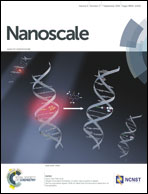A super intramolecular self-enhanced electrochemiluminescence immunosensor based on polymer chains grafted on palladium nanocages
Abstract
An intramolecular self-enhanced electrochemiluminescent derivative is prepared by grafting polystyrene (PS)-based polymer chains with pendant Ru(II) luminophore from poly(ethylenimine) (PEI) on the surface of palladium nanocages (PdNCs). In this way, the Ru(II) luminophore and its co-reactive group (amine groups in PEI) exist in the same polymer molecule, which shortens the electronic transmission distance between them and enhances the luminous stability. Meanwhile, through atom transfer radical polymerization (ATRP), the loading amount of Ru(II) luminophore is greatly increased. Therefore, the obtained electrochemiluminescent derivative (PdNC–PEI–PSRu) has high luminous efficiency and stability. Furthermore, due to their special nanostructures of porous walls and hollow interiors, PdNCs have great advantages in high specific surface areas and good electrocatalytic ability, which make them act as an excellent immobilized platform for PEI and detection antibody. Based on the sandwiched immunoreactions, a sensitive “signal on” electrochemiluminescence immunosensor is constructed for the detection of carbohydrate antigen 15-3 (CA 15-3). As a result, a wide linear range from 0.01 U mL−1 to 120 U mL−1 is acquired with a relatively low detection limit of 0.003 U mL−1.


 Please wait while we load your content...
Please wait while we load your content...